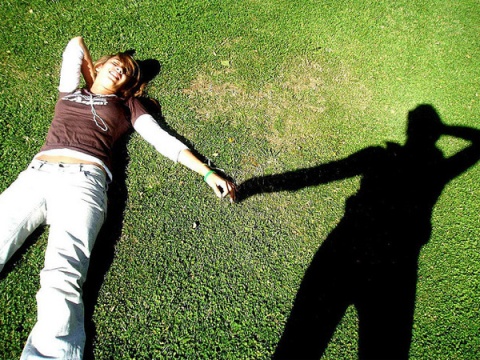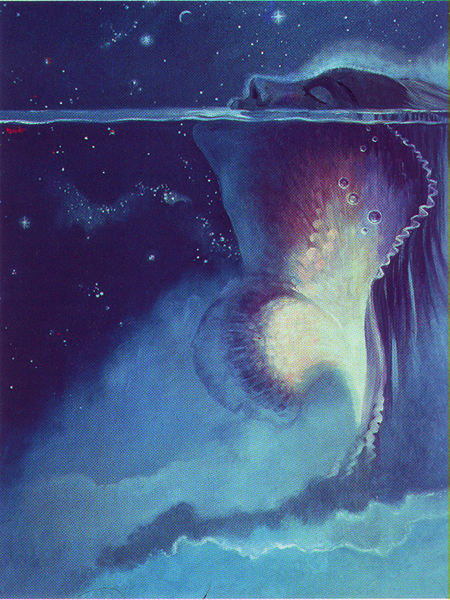Navigating The Dark Night of the Soul
October 30, 2012 § 18 Comments
By Tai Carmen “The night sea journey takes you back to your primordial self, not the heroic self that burns out and falls to judgment, but to your original self, yourself as a sea of possibility, your greater and deeper being.” ~ Thomas Moor
“The night sea journey takes you back to your primordial self, not the heroic self that burns out and falls to judgment, but to your original self, yourself as a sea of possibility, your greater and deeper being.” ~ Thomas Moor
“There is no coming to consciousness without pain. People will do anything, no matter how absurd, to avoid facing their own soul. One does not become enlightened by imagining figures of light, but by making the darkness conscious.” ~ Carl Jung
“Fear is a natural reaction to moving closer to the truth” ~ Pema Chödrön
So named after St. John of the Cross’ classic religious poem of the same title, the dark night of the soul is described by seekers of all mystical traditions as an important stage of the quest for deeper knowledge — as unavoidable as confronting the dragon who guards the treasure in every mythic hero’s story.
“The mythological goal of the dragon fight is almost always the virgin, the captive, or more generally, the ‘treasure hard to attain.’ This image of the vulnerable, beautiful, and enchanting woman, guarded by and captive of a menacing monster gives us a picture of the inner core of the personality and its surrounding defenses,” relates Donald Kalsched in Myth & Psyche.
The maiden or treasure on the other side of the dragon symbolize our own inner wealth or spirit, awaiting reunion with the conscious mind, guarded by the ego and shadow-side aspects of the personality.
“Only one who has risked the fight with the dragon,” notes the great Swiss psychiatrist Carl Jung, “and is not overcome by it wins the hoard, the ‘treasure hard to attain’. . . . he has faced the dark ground of his self and thereby gained himself.”
In myth and life alike, when the seeker first sets out upon the path, it is often not by choice but by necessity. To live in denial of the call simply becomes unbearable. Many times transformation is triggered by a crisis of meaning, forcing a reassessment of values and priorities.
Increased awareness shines a light on dark corners of the personality and/or the world at large. So the dark night period is really a sign that transformation is occurring — the labor pains of personal rebirth.
If processed, all who have undergone the dark night of the soul agree that it is ultimately a doorway to deeper awareness and understanding. On the other side awaits a more authentic self and a broader concept of the world. But in the meantime the false constructs and denied aspects of self become increasingly uncomfortable, even painful, giving the impression that something awful is happening, when, in fact, this period can be seen as nature’s way of encouraging regeneration — as a snake’s partly shed skin irks and itches him until he rubs the husk off entirely.
Because of his powerful ability to shed old layers of himslef, mystical traditions the world over associate the snake with transformation and regeneration.
Jesus had his forty days in the desert, Jonah his time in the belly of the whale. In Star Wars, when Luke Skywalker asks Yoda what he will encounter in his first test, the mini master replies: “Only what you take with you.”
“Everyone carries a shadow,” Jung wrote, “and the less it is embodied in the individual’s conscious life, the blacker and denser it is.” In other words, the more we deny it, the more power the shadow self has over us.
“The Shadow is an archetype—a universal motif or image built in to all human beings. You can no more get rid of this inner Shadow than you can avoid casting an outer shadow when you’re in sunlight. For most of us, that creates a problem, because the Shadow appears as the sum total of the weakest, most flawed, inferior or even disgusting parts of yourself. It’s everything you don’t wish to be, but fear that you are.” (“The Tools” by Phil Stutz.)
When one is experiencing a dark night of the soul, one inevitably comes face to face with one’s shadow side.
“Most of us do not take these situations as teachings,” says Zen monk and author Pema Chödrön. “We automatically hate them. We run like crazy. We use all kinds of ways to escape — all addictions stem from this moment when we meet our edge and we just can’t stand it. We feel we have to soften it, pad it with something, and we become addicted to whatever it is that seems to ease the pain.”
Continues Chödrön,”It’s a transformative experience to simply pause instead of immediately trying to fill up the space. By waiting, we begin to connect with fundamental restlessness as well as fundamental spaciousness.” By spaciousness, Chödron means the vast calm available to us in the “inner space” of turning inward in meditation and conscious presence. (For more on third eye meditations and inner space travel see “The Art of Seeing: Third Eye Perception and the Mystical Gaze”).
“It takes a long time to learn to listen to the still, small voice within,” notes Psychology Today writer Wendy Lustbader. “We tend to seek direction outside ourselves, while our soul’s language is drowned out by the commotion of day-to-day doings, all the external strivings that distract us.
“It is possible to lose awareness of this inner voice for years and to be carried along by the force of society’s dictates and other people’s conceptions of a worthy life. At any point in the lifespan, suffering makes our need to hear what is within acute.”
“We see our Shadow as a source of humiliation that we try to hide—usually through some kind of perfectionism,” explains Phil Stutz. “The counter-intuitive truth is that when we reveal the Shadow… its nature changes. It becomes a source of creativity and confidence.”
This is because it has been noted by students of the psyche, and Jung in particular, that, as psychologist Ken Page puts it: “Our deepest wounds surround our greatest gifts.” Continues Page, “Cervantes said that reading a translation is like viewing a tapestry from the back. That’s what it’s like when we try to understand our deepest struggles without honoring the gifts that fuel them.”
“Core gifts are not the same as talents or skills,” continues Page. “In fact, until we understand them, they often feel like shameful weaknesses, or as parts of ourselves too vulnerable to expose.” He gives examples of a client who feels she is “too much,” whose core gift is passion. Another who feels he is “not enough,” whose core gift is humility.
“Yet [these vulnerable parts of ourselves] are where our soul lives…” Page observes. “But gifts aren’t hall-passes to happiness. They get us into trouble again and again. We become most defensive-or most naïve-around them. They challenge us and the people we care about. They ask more of us than we want to give. And we can be devastated when we feel them betrayed or rejected…”
“Since the heat of our core is so hard to handle,” details Page, “we protect ourselves by moving further out from the center. Each ring outward represents a more airbrushed version of ourselves. Each makes us feel safer, puts us at less risk of embarrassment, failure, and rejection. Yet, each ring outward also moves us one step further from our soul, our authenticity, and our sense of meaning…
“So, most of us set up shop at a point where we are close enough to be warmed by our gifts, but far enough away that we do not get burned by their fire. We create safer versions of ourselves to enable us to get through our lives without having to face the existential risk of our core.” (“How Our Insecurities Can Reveal Our Deepest Gifts”).
Considering these angles, it becomes easier to see how the symbolic dragon of the shadow side protects our greatest riches, and how shining a light on our darkness is one time-tested way to liberate the luminous gold of our authentic self.
The only way out is through. Once we begin to see the value in our shadow aspects and dark night periods — whether it’s a dark night day, month or year — we can learn to stop resisting the discomfort and surrender to the process, to view it as an initiation, a transition. If we view every aspect of the journey as sacred, we are better able to glean its gifts, for behind the dark night awaits a silver dawn.










